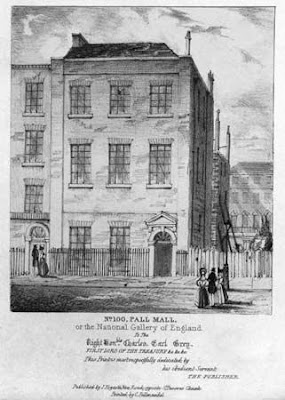The National Gallery opened to the public on 10 May 1824, housed in Angerstein's former townhouse on No. 100 Pall Mall. Angerstein's paintings were joined in 1826 by those from Beaumont's collection, and in 1828 by the Reverend William Holwell Carr's bequest of 34 paintings. Initially the Keeper of Paintings, William Seguier, bore the burden of managing the Gallery, but in July 1824 some of this responsibility fell to the newly formed board of trustees.
The National Gallery at Pall Mall was frequently overcrowded and hot and its diminutive size in comparison with the Louvre in Paris was the cause of national embarrassment. But Agar Ellis, now a trustee of the Gallery, appraised the site for being "in the very gangway of London"; this was seen as necessary for the Gallery to fulfil its social purpose. Subsidence in No. 100 caused the Gallery to move briefly to No. 105 Pall Mall, which the novelist Anthony Trollope described as a "dingy, dull, narrow house, ill-adapted for the exhibition of the treasures it held." This in turn had to be demolished for the opening of a road to Carlton House Terrace.
In 1832 construction began on a new building by William Wilkins on the site of the King's Mews in Charing Cross, in an area that had been transformed over the 1820s into Trafalgar Square. The location was a significant one, between the wealthy West End and poorer areas to the east. The argument that the collection could be accessed by people of all social classes outstripped other concerns, such as the pollution of central London or the failings of Wilkins's building, when the prospect of a move to South Kensington was mooted in the 1850s. According to the Parliamentary Commission of 1857, "The existence of the pictures is not the end purpose of the collection, but the means only to give the people an ennobling enjoyment".

No comments:
Post a Comment